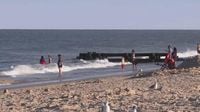As Labor Day weekend arrives, many Americans are preparing for what’s traditionally a final, sun-soaked hurrah at the nation’s beaches. Yet, this year, an unsettling reality is waiting at the water’s edge: across the United States, a growing number of popular beaches are warning swimmers to stay out of the water due to high levels of fecal contamination. The warnings, which stretch from the Gulf Coast to the Great Lakes and all the way to the Hawaiian Islands, have cast a shadow over what should be a celebratory end to summer.
According to reports by the Associated Press and Environment America, thousands of beachgoers this August 30, 2025, are being met with advisories or outright closures at many of their favorite spots. These advisories, posted at beaches from Crystal River, Florida, to Ogunquit, Maine, caution that swimming could expose people to bacteria linked to fecal waste—posing risks of gastrointestinal illness, skin rashes, and nausea.
Some of the nation’s most beloved sandy stretches have not been spared. Keyes Memorial Beach in Hyannis, Massachusetts, Benjamin’s Beach on Long Island in New York, and a portion of Imperial Beach near San Diego have all faced closures or advisories this week. Even the typically pristine white sands of Hawaii are affected, with the Hawaii State Department of Health warning of high bacteria counts at Kahaluu Beach Park on the Big Island, as reported by AP.
The scope of the problem is both longstanding and widespread. In a report issued this summer, Environment America found that nearly two-thirds of all beaches tested nationwide in 2024 had at least one day where bacteria levels associated with fecal contamination reached potentially unsafe thresholds. The numbers are even more staggering in certain regions: 84% of Gulf Coast beaches, 79% of West Coast beaches, 54% of East Coast beaches, and 71% of Great Lakes beaches exceeded federal safety standards at least once during the year.
More than 450 beaches were deemed potentially unsafe for swimming on at least a quarter of the days they were tested, according to the group’s findings. These figures are not just statistics—they represent days when families, children, and tourists may have unknowingly waded into waters carrying hidden health risks.
So, what’s behind this surge in contamination? The primary culprit, experts say, is aging and outdated water and sewer infrastructure. John Rumpler, clean water director and senior attorney with Environment America, explained to AP, “These beaches are a treasure for families across New England and across the country. They are a shared resource. We need to make the investment to make sure that literally our own human waste doesn’t wind up in the places where we are swimming.”
But the problem isn’t just old pipes and leaky sewers. Increasingly severe weather events, like hurricanes and heavy downpours, can overwhelm already struggling sewage systems, leading to overflows that spill bacteria-laden waste into the ocean. Suburban sprawl, which replaces natural landscapes with paved surfaces, further reduces the land’s ability to absorb stormwater, pushing more runoff—and contaminants—into waterways. As Rumpler put it, the combined effect is that “contamination from sewage reaches the places where people swim.”
The impact of these factors has been felt acutely in places like North Carolina, where five beaches were under advisories in late August 2025 due to elevated fecal bacteria levels. Erin Bryan-Millush, environmental program supervisor with the North Carolina Department of Environmental Quality, told AP that Hurricane Erin and heavy rain events this summer have exacerbated the problem. “Those storm drains carry everything,” Bryan-Millush said. “It could be really bad for someone who is immune compromised.”
Despite the warnings, many beachgoers remain undeterred. At Rehoboth Beach in Delaware, where some local beaches including Rehoboth Bay and Dewey Beach bayside were under advisories this week, visitors appeared largely unconcerned. “I really don’t expect to be in any kind of danger of fecal contamination,” said Yaromyr Oryshkevych, a retired dentist, in comments to AP and News18. He reasoned that Rehoboth wasn’t close enough to major pollution sources to be a worry, and he trusted the ocean’s natural currents to disperse any contaminants.
Dana West, a federal worker visiting Rehoboth Beach, recounted a less fortunate experience earlier in the year. After a snorkeling excursion off the coast of Isla Mujeres, Mexico, a dozen members of his vacation group developed gastrointestinal issues, likely from swallowing contaminated seawater. Still, West said he wasn’t worried about Delaware’s beaches. “But generally, I have no concerns about the level of fecal and bacterial matter,” he told AP. “I assume the local authorities will tell us if there are higher levels than normal.”
Yet, as Environment America’s report highlights, advisories are not always clearly posted, and many swimmers may be unaware of the risks. The group’s assessment of beach safety relied on whether fecal bacteria levels exceeded standards set by the U.S. Environmental Protection Agency—levels that, if surpassed, can cause illness in 32 out of every 1,000 swimmers, according to the AP.
For public health officials, the challenge is not just monitoring and issuing warnings, but also addressing the root causes of contamination. Upgrading water and sewer systems is a massive and costly undertaking, but advocates like Rumpler argue it’s essential for protecting both public health and the economic value of America’s beaches. After all, these shorelines are not only places of recreation—they’re vital to local economies, drawing millions of tourists and supporting countless businesses each year.
Meanwhile, the problem shows no signs of abating. Severe weather events are becoming more frequent and intense, putting additional strain on already fragile infrastructure. As suburban development continues to sprawl outward, the natural buffers that once helped filter stormwater are disappearing. And with climate change expected to bring even heavier rains and higher sea levels, experts warn that the risks of contamination could only increase in the years ahead.
For now, the message to beachgoers is clear: check local advisories before heading into the water, and be aware that even the most inviting waves may harbor unseen dangers. As Rumpler emphasized, America’s beaches truly are a shared resource—and safeguarding them will require shared responsibility, investment, and vigilance from communities, policymakers, and visitors alike.
This Labor Day, as families gather for one last splash of summer, the hope is that renewed awareness and action will help ensure these treasured coastlines remain safe for generations to come.






